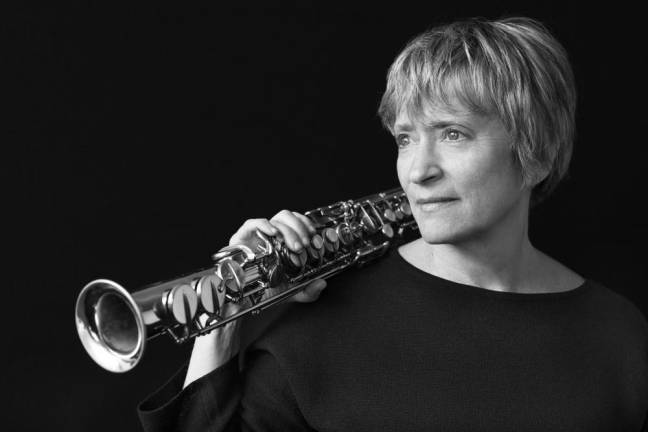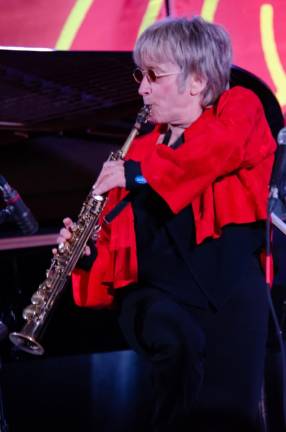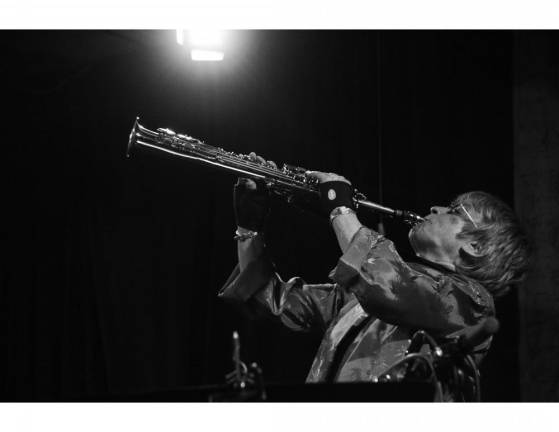Immersed in a World of Jazz and Space
Grammy Award-winning saxophonist and composer, Jane Ira Bloom, on her musical journey



Jane Ira Bloom began playing the saxophone at age 9 and said she choose the instrument because it was shiny. “It’s a fact. It was public school; they gave you a list,” said Bloom, a Boston native. “You could choose what instrument you wanted to play, and it looked so great in the case.”
A graduate of the Yale School of Music, she first moved to Chelsea in 1979 with her college roommate. Her parents grew up in New York City and saw Ella Fitzgerald and Duke Ellington perform here, so when she got to Manhattan, she said “it was like returning home.”
In 2018, she won a Grammy Award for Best Surround Sound Album for her work “Early Americans.” The award sits on the piano in her Upper West Side apartment, where she lives with her husband, actor Joe Grifasi. The three-time Grammy nominee was recently nominated for a 2023 Grammy for Best Immersive Audio Album for “Picturing the Invisible,” a group effort she fondly referred to as a “girl power project” because of all the females who were part of her musical team.
Funding for the album was made possible by a grant from the NYC Women’s Fund for Media, Music and Theatre. Since it began in 2018, the grant program, administered by the New York Foundation for the Arts in partnership with the City of New York Mayor’s Office of Media and Entertainment, has given $5.5 million to women for a total of 246 film, theatre and music endeavors.
As for her future plans, Bloom, whose impressive resume includes being the first musician commissioned by the NASA Art Program, wants to continue working on projects in immersive sound. “I’m thrilled to be in that world,” she said, “and discovering how you can communicate your musical ideas with great depth and dimension to other people.”
When did you know you wanted to pursue music professionally?
I always knew I was a musician in my bones from the time I was on the planet. I’m sure many musicians tell you that. But, to be honest, I didn’t know that it was going to be my direction as a professional artist until my final year of college. I can remember doing my senior recital saying, “I don’t have a choice. This is all I could do.”
What did you study at Yale?
I was a music major undergraduate and a performance major as a graduate student in saxophone. But at Yale, there’s no such thing as performance undergrad, so it’s theory, history and composition, that kind of thing.
Where was the first place you performed in the city?
You would never have heard of it because it was in the loft years. I played at this loft space on 18th Street in Chelsea called The Brook. It was where all kinds of creative musicians performed. I was playing saxophone and bass improvised duets at the time.
I read an interview with you about COVID where you said jazz artists are used to improvising.
Fortunately, I’ve been quite cautious, but no, I haven’t contracted COVID yet. But I’ve been very, very careful, myself and my husband. Interestingly enough, over the course of the pandemic, and also having to do with my collaboration with Grammy-nominated audio engineer and producer Ulrike Schwarz, who I did the “Picturing the Invisible” project with, I’ve become quite adept at doing remote recordings where I’m playing live with other musicians in real time over the internet. And I’ve recorded four different albums that way. It’s astonishing what we’re able to do.
Tell us about the grant from NYC Women’s Fund for Media, Music and Theatre and how it helped you with that project.
The Mayor’s Office of Media and Entertainment has a fund together with the New York Foundation for the Arts. So they’re empowering women artists to create. And this was during the pandemic. And we were very fortunate to get this grant with a project that was definitely girl power. We were inspired by a legendary woman photographer by the name of Berenice Abbott; that’s what I wrote the music about. I’m the composer, I’m the performer. I performed with astonishing, legendary women improvising artists. A woman named Allison Miller on drums and percussion, Miya Masaoka on koto.
And then my partner, my collaborator in this project, is Grammy-nominated audio engineer and producer Ulrike Schwarz. We came up with this idea of “How about we do some remote duet recording,” where she records in high-definition surround sound. So it’s like art and science are at a real high level together and it’s all women. We have just a few honorary guys, Mark Helias is playing bass and Jim Anderson and Morton Lindberg, mixing and mastering engineers, were also part of the nominated production team, but for sure we’re definitely a girl power project, no question about it.
Do you get to go to next year’s Grammy Awards? Have you been before?
Yeah, we’re flying out February 3. One time I went to Los Angeles, for our first Grammy nomination, but we lost to Paul McCartney. [Laughs] And the second time we went, was in 2018, where the Grammys were held at Madison Square Garden, and that’s where we won the Grammy for an album of mine called “Early Americans.” It was so cool. You know who gave us the Grammy? Neil Degrasse Tyson. I said, “Wow, astrophysicist, not bad.”
Speaking about science, you were the first musician ever commissioned by the NASA Art Program. How did that come about?
It’s a great story. In the 1980s, things weren’t going so great with my career and I wrote a letter in the dark to NASA to inquire about if they’d done any research on the future of the arts in space. I was always interested in zero gravity and what music might be like in a zero-gravity environment. Anyway, six months go by, and I got a letter back from a gentleman by the name of Robert Schulman, who at that time was the head of something I didn’t even know existed, called the NASA Art Program. And, fortunately for me, Bob was also an avid jazz fan, so we corresponded over many years. And eventually I just suggested the idea, “How about commissioning the very first musical artist instead of visual artist?” And that’s how it began.
And then you got an asteroid named after you?
Yeah, that was a surprise to me. But it turns out that a jazz fan happens to be an astronomer in Flagstaff, Arizona, where one of the observatories is. And the rule is, when you discover an asteroid, you’re allowed to name it. And it turns out this guy was listening to one of my albums called “Art and Aviation” when he discovered the asteroid. I’m told I have a very eccentric orbit, so ... [Laughs]
You’re also a professor at The New School. How many classes do you teach there?
Yes, I’m a professor of jazz and contemporary music there. And I’ve been there for almost 25 years. It varies, but usually I have a load of three to four courses I teach each semester.
I saw on your Wikipedia page that your husband is an actor and played two Yankees.
Yes, in “The Bronx is Burning,” he played Yogi Berra and Phil Rizzuto in “61*.” The only thing that’s inaccurate on Wikipedia is that we did not get married in 1974; we were married in 1984.
Where did you meet?
Joe was at Yale Repertory Theatre and I had just graduated from Yale School of Music, so we met at Yale.